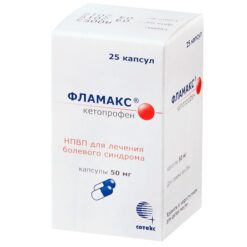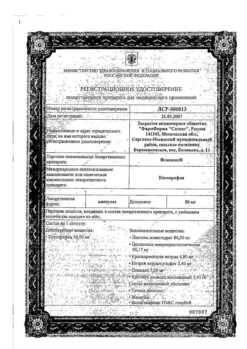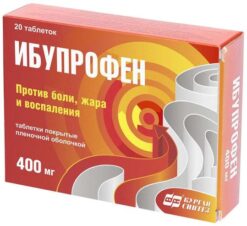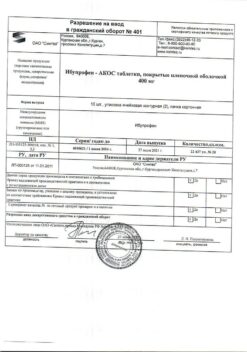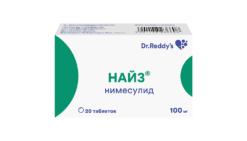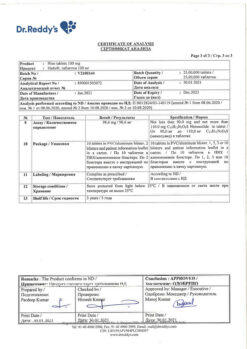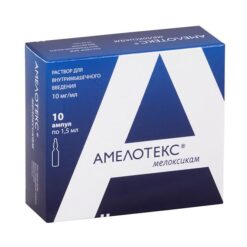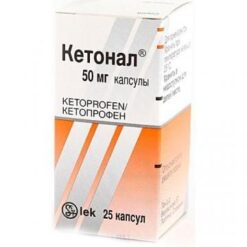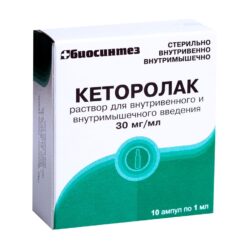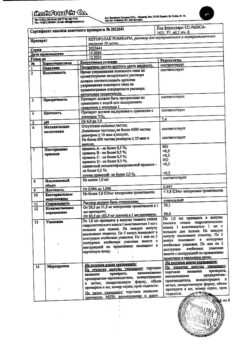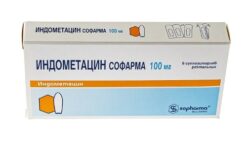No products in the cart.
Naclofen SR, 100 mg 20 pcs
€1.00
Out of stock
(E-mail when Stock is available)
Description
Diclofenac is a non-steroidal anti-inflammatory drug with analgesic, anti-inflammatory and antipyretic effects.
Indications
Indications
– inflammatory and degenerative diseases of the musculoskeletal system: rheumatoid arthritis, psoriatic, juvenile chronic arthritis, ankylosing spondylitis (Bechterew’s disease), gouty arthritis (in an acute attack, fast-acting dosage forms are preferable), arthritis in Reiter’s disease, rheumatic soft tissue lesions, osteoarthritis of peripheral joints and the spine, including radicular syndrome, tendovaginitis, periarthritis, bursitis, myositis, synovitis).
Pain syndrome of mild to moderate severity: neuralgia, myalgia, lumboishyalgia, post-traumatic pain syndrome accompanied by inflammation, postoperative pain, headache, migraine (in an acute attack, quick-acting dosage forms are preferable), algodysmenorrhea, adnexitis, proctitis, toothache, renal and biliary colic;
– as part of the complex therapy of infectious and inflammatory diseases of the ear, throat, nose with a pronounced pain syndrome (pharyngitis, tonsillitis, otitis);
– febrile syndrome.
Diclofenac is intended for symptomatic therapy and has no effect on the progression of the disease.
Active ingredient
Active ingredient
Composition
Composition
1 film-coated tablet contains:
Diclofenac sodium 100 mg
Harmful substances:
Saccharose,
Cetyl alcohol,
povidone,
colloidal silicon dioxide,
anhydrous,
magnesium stearate
Shell:
Hypromellose, iron oxide red dye (E172), titanium dioxide, macrogol 6000, polysorbate 80, talc
How to take, the dosage
How to take, the dosage
Overly, tablets should be swallowed whole, without chewing, with plenty of water during or after a meal.
Naclofen CP, sustained release tablets, 100 mg should be used for long-term therapy. The initial and maintenance doses are 1 tablet per day. If it is necessary to increase the dose to 150 mg per day, Naclofen CP should be combined with Naclofen tablets or suppositories of 50 mg.
Interaction
Interaction
Enhances plasma concentrations of digoxin, methotrexate, lithium drugs and cyclosporine.
Decreases the effect of diuretics, against potassium-saving diuretics increases the risk of hyperkalemia; against anticoagulants, antiplatelet and thrombolytic drugs (alteplase, streptokinase, urokinase) increases the risk of bleeding (more often GI).
Limits the effect of hypotensive and sleeping pills.
Increases the likelihood of side effects of other NSAIDs and glucocorticosteroids (gastrointestinal bleeding), methotrexate toxicity and cyclosporine nephrotoxicity.
Acetylsalicylic acid reduces the blood concentration of diclofenac. Concomitant use with paracetamol increases the risk of nephrotoxic effects of diclofenac.
Hypoglycemic agents – hypo- or hyperglycemia may be observed. In this combination of drugs it is necessary to control the blood glucose concentration.
Cefamandol, cefoperazone, cefotetan, valproic acid and plikamycin increase the incidence of hypoprothrombinemia.
Cyclosporine and gold drugs increase the effect of diclofenac on prostaglandin synthesis in the kidneys, which is manifested by increased nephrotoxicity.
Selective serotonin reuptake inhibitors increase the risk of GI bleeding.
Concomitant administration with ethanol, colchicine, corticotropin and St John’s wort preparations increases the risk of GI bleeding.
Drugs that cause photosensitization increase the sensitizing effect of diclofenac to ultraviolet radiation.
Drugs that block tubular secretion increase the plasma concentration of diclofenac, thereby increasing its toxicity.
Antibacterial drugs from the quinolone group – risk of seizures.
Special Instructions
Special Instructions
Contraindications
Contraindications
– period after coronary artery bypass grafting;
– erosive and ulcerative changes of the mucous membrane of the stomach or duodenum, active gastrointestinal bleeding;
– inflammatory intestinal diseases in the acute phase (Non-Specific Ulcerative Colitis (NUTC), Crohn’s Disease.
– inflammatory bowel disease, in the acute phase (Non-Specific Ulcerative Colitis (NUC), Crohn’s Disease).
– cerebrovascular bleeding or other bleeding and hemostasis disorders;
– expressed hepatic insufficiency or active liver disease;
– Severe renal insufficiency (creatinine clearance less than 30 ml/min), including confirmed hyperkalemia, advanced renal disease;
– decompensated heart failure;
– inhibition of medullary hematopoiesis;
– third trimester of pregnancy, breastfeeding;
– childhood (under 18 years);
– Hypersensitivity to diclofenac; Complete or incomplete combination of bronchial asthma, recurrent nasal and paranasal sinus polyposis, and intolerance to acetylsalicylic acid and other NSAIDs (including history ofincluding a history).
With caution: Coronary heart disease, cerebrovascular disease, dyslipidemia/hyperlipidemia, diabetes mellitus, peripheral artery disease, smoking, creatinine clearance less than 60 ml/min; anamnestic data on the development of gastrointestinal ulcers, the presence of Helicobacter pylori infection, advanced age, long-term use of nonsteroidal anti-inflammatory drugs (NSAIDs), frequent use of alcohol, severe somatic diseases, inducible porphyria, epilepsy, advanced age, diverticulitis, systemic connective tissue diseases, significant decrease in circulating blood volume (CBC) (including after massive surgery), elderly patients (administered at lower doses) (including those receiving diuretics, weakened patients and low body weight), concomitant therapy with the following drugs anticoagulants (e.g., warfarin), antiaggregants (e.g., acetylsalicylic acid, clopidogrel), fibrinolytics, oral glucocorticoids (e.g., prednisolone), selective serotonin reuptake inhibitors (e.g., citalopram, fluoxetine, paroxetine, sertraline). To reduce the risk of gastrointestinal adverse events, the lowest effective dose should be used in as short a course as possible. Pregnancy I-II trimester.
Side effects
Side effects
Frequently, 1-10%; sometimes, 0.1-1%; rarely, 0.01-0.1%; very rarely, less than 0.01%, including isolated cases.
Digestive system disorders: frequent – epigastric pain, abdominal cramps, nausea, vomiting, diarrhea, dyspepsia, flatulence, anorexia, increased aminotransferase activity; rare – gastritis, proctitis, gastrointestinal tract (GIT) bleeding (vomiting with blood, melena, diarrhea with blood admixture), GIT ulcers (with or without bleeding or perforation), hepatitis, jaundice, liver function impairment; very rarely – stomatitis, glossitis, dry mucous membranes (including mouth), esophageal damage, diaphragm-like intestinal strictures (nonspecific hemorrhagic colitis, exacerbation of ulcerative colitis or Crohn’s disease), constipation, pancreatitis, lightning hepatitis.)
Nervous system disorders: frequently – headache, dizziness; rarely – somnolence; very rarely – sensory disorders, including paresthesia, memory disorders, tremor, seizures, anxiety, cerebrovascular disorders, aseptic meningitis, disorientation, depression, insomnia, nightmares, irritability, agitation, mental disorders.
Sensory organs: often – vertigo; very rare – visual impairment (blurred vision, diplopia), hearing impairment, tinnitus, impaired sense of taste.
Urinary system disorders: very rarely – acute renal failure, hematuria, proteinuria, interstitial nephritis, nephrotic syndrome, papillary necrosis, edema.
Hematopoietic organs: very rarely – thrombocytopenia, leukopenia, eosinophilia, hemolytic and aplastic anemia, agranulocytosis.
Allergic reactions: anaphylactic, anaphylacoid reactions, including marked decrease in blood pressure (BP) and shock; very rare – angioedema (including facial), in some cases vasculitis.
Cardiovascular system disorders: very rarely – palpitation, tachycardia, extrasystole, chest pain, increased BP, vasculitis, heart failure, myocardial infarction.
Respiratory system disorders: rarely – cough, bronchial asthma (including dyspnea); very rarely – pneumonitis, laryngeal edema.
The skin: often – skin rash, rarely – urticaria, very rarely – bullous rash, eczema, including multiforme and Stevens-Johnson syndrome, Lyell syndrome, exfoliative dermatitis, itching, hair loss, photosensitization, purpura, including allergic.
Overdose
Overdose
Symptoms: vomiting, nausea, abdominal pain, GI bleeding, diarrhea, headache, dizziness, tinnitus, hyperexcitability, hyperventilation phenomena with increased seizure readiness, seizures, with significant overdose – acute renal failure, hepatotoxic effect.
Treatment: gastric lavage, activated charcoal, symptomatic therapy aimed at elimination of increased BP, impaired renal function, convulsions, gastrointestinal irritation, respiratory depression. Force diuresis, hemodialysis are ineffective (significant protein binding and intensive metabolism). In order to decrease the risk of gastrointestinal tract adverse events the lowest effective dose should be used for the shortest possible course.
The drug should be used with caution in ulcerative colitis and Crohn’s disease because of possible exacerbation of the disease.
In prolonged use of diclofenac it is possible, although rare, to develop serious hepatotoxic reactions, and therefore it is recommended to monitor liver function regularly.
Because of the important role of prostaglandins in maintaining renal blood flow, special caution should be exercised when prescribing the drug in patients with cardiac or renal insufficiency, as well as during therapy in elderly patients who take diuretics and patients who for any reason have reduced circulating blood volume (e.g., after major surgical intervention). If diclofenac is prescribed in these cases, it is recommended as a precaution to monitor renal function.
With caution, diclofenac should be prescribed in patients with severe renal or hepatic impairment, heart failure, clotting disorders, porphyria, epilepsy, and in patients receiving anticoagulants or fibrinolytics.
When prolonged therapy it is necessary to monitor the peripheral blood count, to conduct fecal occult blood test.
Due to the negative effect on fertility, the drug is not recommended for women who want to become pregnant. In patients with infertility (including those undergoing examination) it is recommended to discontinue the drug.
Patients taking the drug should refrain from drinking alcohol.
In infectious diseases, the anti-inflammatory and antipyretic effects of diclofenac sodium may mask the symptoms of these diseases.
The amount of sucrose contained in the drug does not affect patients with the following conditions: enzyme deficiency of lactase, ralactosemia and impaired glucose/galactose absorption syndrome.
Impact on the ability to drive or drive other motor vehicles
Mental and motor reaction times may decrease during treatment; therefore, it is necessary to refrain from engaging in potentially dangerous activities requiring increased concentration and rapid psychomotor reactions.
It is contraindicated in severe hepatic insufficiency or active liver disease.
Similarities
Similarities
Additional information
| Shelf life | 5 years. |
|---|---|
| Conditions of storage | Store at a temperature not exceeding 25 ° C. |
| Manufacturer | KRKA dd Novo mesto, Slovenia |
| Medication form | sustained release tablets |
| Brand | KRKA dd Novo mesto |
Related products
Buy Naclofen SR, 100 mg 20 pcs with delivery to USA, UK, Europe and over 120 other countries.


